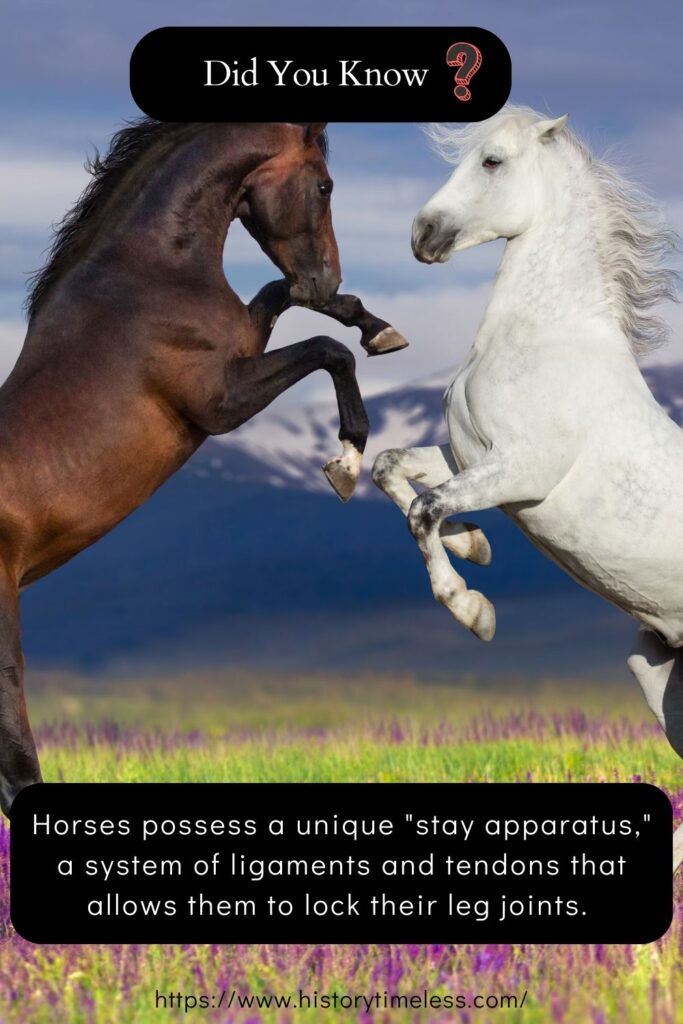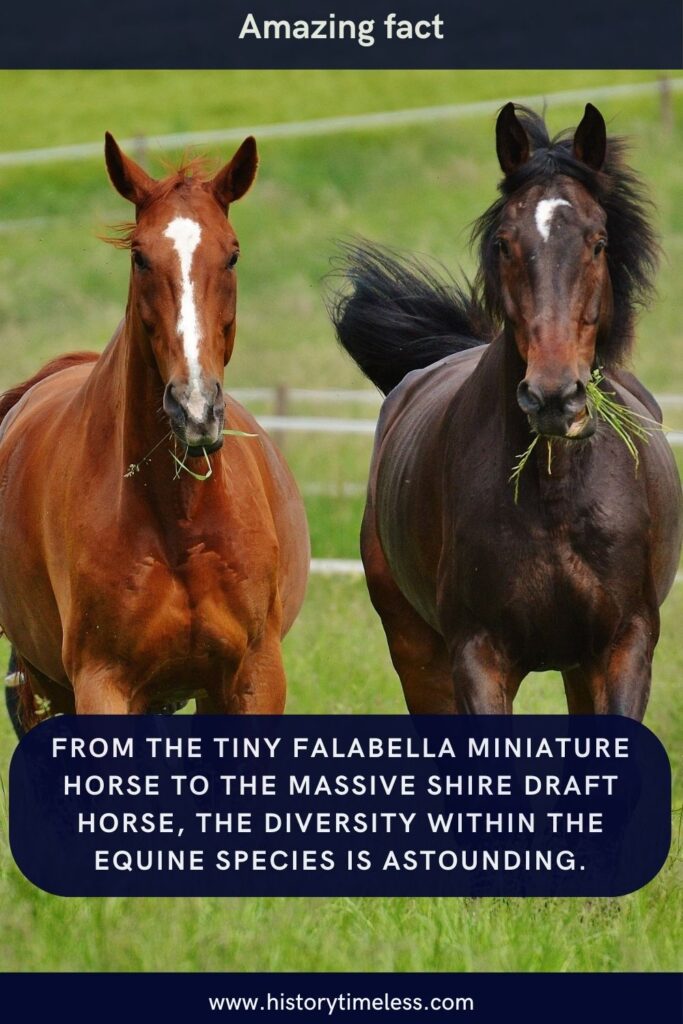Horses are truly magnificent creatures, capturing our imagination with their grace, power, and deep connection to human history. From their unique physical abilities to their complex social behaviors, there’s so much more to these animals than meets the eye.
Whether you’re a lifelong equestrian or simply admire them from afar, horses offer a world of wonder. Prepare to be amazed as we delve into some incredible and sometimes surprising facts about these beloved companions.
Exploring aspects of their biology, behavior, and the special bond they share with us. Let’s saddle up and discover the world of horses!
1. Horses Can Sleep Both Standing Up and Lying Down
Horses possess a unique “stay apparatus,” a system of ligaments and tendons that allows them to lock their leg joints.

This incredible adaptation enables them to doze lightly while standing, conserving energy and remaining ready to flee from potential predators instantly. However, for deep REM sleep, which is crucial for rest and recovery, horses must lie down completely.
They typically only need an hour or two of this deep sleep, often taken in short bursts, feeling secure enough in their environment to be vulnerable.
2. Their Eyes Offer an Almost 360-Degree View
Positioned on the sides of their head, a horse’s large eyes provide an exceptionally wide field of vision, close to 360 degrees. They have only two small blind spots: directly behind their hindquarters and immediately in front of their face.
This panoramic view is a vital defense mechanism for a prey animal, allowing them to spot potential danger approaching from nearly any direction.
While they excel at detecting motion in their peripheral vision, their binocular vision (using both eyes together) directly ahead is narrower but provides better depth perception.
3. Horses Are Herbivores Designed for Constant Grazing
As natural herbivores, horses evolved to graze on grasses and other plant material for the majority of their day, often up to 15-17 hours. Their digestive system is specifically adapted for this continuous intake of high-fiber forage.
Unlike predators who eat large meals infrequently, horses have relatively small stomachs and a long, complex hindgut where fermentation breaks down tough plant fibers.
This constant grazing behavior is essential for their physical and mental well-being, keeping their digestive tract functioning properly and satisfying their innate need to forage.
4. Horse Hooves Grow Continuously Like Human Fingernails
A horse’s hoof is a marvel of natural engineering, constantly growing throughout its life, much like our own fingernails or hair. The hoof wall grows downwards from the coronary band at the top of the hoof.
In the wild, this growth is naturally worn down by constant movement over varied terrain. However, domesticated horses, especially those kept in softer pastures or stables and ridden regularly.
Often require regular trimming and sometimes shoeing by a farrier every 6-8 weeks to maintain proper balance, prevent overgrowth, and ensure hoof health.
5. They Communicate Through Complex Body Language and Sounds
Horses are masters of non-verbal communication, using subtle shifts in posture, ear position, tail swishes, and facial expressions to convey their mood and intentions.
Pinned ears might signal irritation, while pricked ears indicate alertness. They also use vocalizations like whinnies (often for calling), nickers (gentle greeting), snorts (alarm or excitement), and squeals (often during social interactions).
Understanding this intricate language is key for humans interacting safely and effectively with horses, allowing us to interpret their feelings and build trust.
6. Horses Are Highly Social Herd Animals
In their natural state, horses live in social groups called herds, typically led by a dominant mare and protected by a stallion. This herd structure provides safety in numbers, allowing for shared vigilance against predators and cooperative raising of foals.
Within the herd, there’s a complex social hierarchy or “pecking order” that dictates access to resources like food and water, minimizing serious conflict.
Domestic horses retain this strong herd instinct, often forming strong bonds with pasture mates and feeling more secure when kept with companions.
7. The Average Lifespan Varies Greatly by Breed and Care
While the average lifespan for a domestic horse is typically between 25 and 30 years, this can vary significantly.
Factors like breed (ponies often live longer than larger breeds), diet, living conditions, healthcare, and workload play crucial roles. Some well-cared-for horses have been known to live into their late 30s or even early 40s.
Advances in veterinary medicine, nutrition, and general horse management practices over the decades have contributed to an overall increase in the longevity of domestic horses compared to their wild ancestors.
8. Horse Height Is Measured in a Unique Unit Called “Hands”
Instead of feet or meters, the standard unit for measuring horse height is the “hand.” One hand equals exactly four inches (10.16 cm). The measurement is taken from the ground up to the highest point of the horse’s withers (the ridge between the shoulder blades).
A horse described as “15.2 hh” is 15 hands and 2 inches tall, which translates to 62 inches (15 hands x 4 inches + 2 inches).
This measuring tradition dates back centuries, providing a standardized way to describe a horse’s size across the equestrian world.
9. You Can Estimate a Horse’s Age By Looking at Its Teeth
A horse’s teeth provide remarkable clues about its age, although it’s more of an estimation than an exact science, especially in older horses.
As horses age, their teeth undergo predictable changes: they erupt at specific times during youth, change shape from oval to more triangular, develop a groove (Galvayne’s groove) down the side of the upper corner incisor, and show distinct wear patterns on the biting surfaces.
Experienced horse professionals and veterinarians can examine these characteristics to make a reasonably accurate assessment of a horse’s age.
10. Foals Can Stand and Run Shortly After Birth
As prey animals, newborn horses (foals) need to be mobile very quickly to survive. Within just an hour or two of being born, a healthy foal will typically manage to struggle to its feet. Shortly after that, it will often be able to walk, trot, and even gallop alongside its mother.
This rapid development is a crucial survival instinct, enabling the foal to keep up with the herd and escape potential danger almost immediately after entering the world, relying on instinct and its mother’s protection.
11. Horses Have Four Main Natural Gaits
Horses move in distinct ways called gaits. The four main natural gaits, in increasing order of speed, are the walk (a four-beat gait), the trot (a two-beat diagonal gait), the canter (a three-beat gait), and the gallop (the fastest four-beat gait).
Each gait has a specific footfall pattern and rhythm. Some horse breeds also possess additional “gaited” movements, like the smooth four-beat running walk of the Tennessee Walking Horse or the tölt of the Icelandic Horse, which are prized for their comfort and unique motion.
12. There Are Hundreds of Different Horse Breeds Worldwide
From the tiny Falabella miniature horse to the massive Shire draft horse, the diversity within the equine species is astounding. There are hundreds of distinct breeds found across the globe, each developed over generations for specific purposes, climates, and traits.

Breeds differ vastly in size, build, temperament, color, and athletic ability. Whether bred for racing (Thoroughbred), farm work (Belgian Draft), cattle herding (Quarter Horse), or endurance (Arabian), there’s a horse breed suited to virtually every equestrian discipline and human need.
13. Domestication Began Thousands of Years Ago
Evidence suggests horses were first domesticated around 5,500 years ago, likely initially for meat and milk, in the Eurasian Steppes (modern-day Kazakhstan). Riding and use as transport animals followed later.
This partnership between humans and horses fundamentally changed human history, revolutionizing travel, warfare, agriculture, and trade.
The ability to travel faster and further, transport goods, and gain a military advantage transformed societies worldwide, making the horse one of the most influential domesticated animals in human civilization.
14. The Term “Horsepower” Originated From Actual Horses
The unit of power known as “horsepower” was coined by Scottish engineer James Watt in the late 18th century. He needed a way to compare the power output of his steam engines to that of the draft horses they were designed to replace, primarily in mines.
Watt determined through observation that a typical mine horse could lift 550 pounds one foot high in one second, and he defined this rate of work as one horsepower. Although a simplification, it provided a relatable metric for marketing his engines.
15. Horses Have Extremely Sensitive Skin
Despite their size and strength, horses possess remarkably sensitive skin. They can feel an insect as small as a fly landing anywhere on their body.
This sensitivity is why they often twitch their skin (using the panniculus carnosus muscle) or swish their tails to dislodge pests.
It also means they are sensitive to grooming tools, saddle fit, and rider aids. Understanding this sensitivity is crucial for proper horse care, ensuring equipment fits well and communication through touch (like leg pressure when riding) is gentle yet effective.
16. They Possess Unusually Large Hearts Compared to Body Size
Proportionally, horses have very large hearts, essential for powering their incredible athletic ability. A typical horse’s heart weighs around 8-10 pounds (about 1% of its body weight), but in elite equine athletes like Thoroughbred racehorses, it can be significantly larger.
The famous racehorse Secretariat reportedly had an exceptionally large heart, estimated at over 22 pounds, contributing to his legendary stamina and speed.
This powerful organ efficiently pumps oxygenated blood throughout their body, enabling sustained bursts of speed and endurance.
17. Their Digestive System Prevents Them From Vomiting
Unlike humans and many other animals, horses cannot vomit. The angle at which the esophagus enters the stomach, combined with a very strong cardiac sphincter muscle, creates a one-way system.
While this prevents them from easily expelling toxins or indigestible material, it also makes them highly susceptible to colic (abdominal pain), which can result from digestive upset, blockages, or gas buildup.
This physiological limitation underscores the importance of careful feeding management and prompt veterinary attention for any signs of digestive distress in horses.
18. Horses Drink a Significant Amount of Water Daily
Water is absolutely vital for horse health, playing key roles in digestion, temperature regulation, and overall bodily function. An average-sized horse (around 1,000 lbs) will typically drink between 5 to 10 gallons (about 20 to 40 liters) of fresh, clean water per day.
This amount can increase significantly depending on factors like weather temperature, humidity, level of exercise, diet (horses on dry hay drink more than those on lush pasture), and health status (e.g., nursing mares need more water). Consistent access to water is essential.
19. Regular Grooming Is Important for Health and Bonding
Grooming does more than just keep a horse looking clean; it’s essential for their health and well-being. Brushing removes dirt, loose hair, and dead skin, stimulates blood circulation, and distributes natural skin oils, contributing to a healthy coat.
It also provides an opportunity to check for injuries, skin conditions, ticks, or swelling. Beyond the physical benefits, the routine of grooming helps build trust and strengthens the bond between horse and handler, mimicking the natural social grooming behaviors seen within a herd.
20. Horses Have Excellent Long-Term Memories
Don’t underestimate a horse’s memory! They possess impressive long-term recall, remembering people, places, and past experiences (both positive and negative) for years.
They can recognize handlers and riders even after long periods apart and often remember locations where they experienced fear or pleasure.
This strong memory capacity is why consistent, fair training methods are so important, as horses learn quickly and retain lessons well. Understanding their ability to remember helps handlers build positive associations and avoid reinforcing fearful responses.
21. They Can Sense and Respond to Human Emotions
Horses are incredibly perceptive and attuned to the emotional state of humans around them. Studies have shown they can read human facial expressions and react differently to happy versus angry faces.
They can also sense tension, fear, or confidence in their handlers through subtle changes in body language, heart rate, and even scent.
This sensitivity makes them effective partners in equine-assisted therapy, where they mirror or respond to a patient’s emotional state, providing valuable feedback and facilitating emotional growth and self-awareness.
22. Coat Colors and Patterns Offer Stunning Variety
Equine coat colors are incredibly diverse, ranging from solid blacks, bays, and chestnuts to intricate patterns like pinto (patches of white and another color) and appaloosa (spots).
Genetic modifiers create further variations like palomino (gold coat, white mane/tail), dun (tan/gold with primitive markings), and roan (white hairs mixed with the base coat).
These colors and patterns are determined by complex genetics, and many breed registries are based partly on specific color requirements or characteristics, adding to the visual appeal and uniqueness of individual horses.
23. Horses Played Pivotal Roles Throughout Human History
The history of human civilization is inextricably linked with the horse. Before mechanization, they were the primary means of transportation, essential for trade, communication, and exploration.
In agriculture, they pulled plows and powered machinery. In warfare, cavalry charges could decide battles, providing speed and shock value.
From ancient chariots to medieval knights and Pony Express riders, horses have been indispensable partners, shaping societies, economies, and the course of history itself in profound ways across countless cultures worldwide.
24. Their Athletic Prowess Is Simply Breathtaking
Horses are natural athletes, capable of incredible feats of speed, strength, agility, and endurance. Selective breeding has further specialized these abilities for various equestrian sports.
Racehorses gallop at speeds exceeding 40 mph, show jumpers clear towering obstacles with grace and power, dressage horses perform intricate ballet-like movements, and endurance horses cover challenging 100-mile courses in a day.
This inherent athleticism, combined with their willingness to partner with humans, makes them exceptional competitors and beloved performers in countless disciplines.
25. Specialized Hoof Care Is Provided by Farriers
Caring for a horse’s hooves is a specialized trade performed by professionals called farriers. Farriers trim excess hoof growth, shape the hoof for proper balance and soundness, and, if necessary, apply horseshoes.
Shoeing protects the hoof from excessive wear, provides support, or corrects conformational issues. A skilled farrier understands hoof anatomy and biomechanics, working carefully to maintain the horse’s comfort and athletic potential.
Regular farrier visits (typically every 6-8 weeks) are a fundamental aspect of responsible horse ownership and crucial for preventing lameness.
26. Horses Grow Thick Winter Coats for Insulation
Horses have a natural ability to adapt to cold weather thanks to their incredible winter coats. As daylight hours decrease in autumn, they begin shedding their shorter summer coat and growing a much thicker, longer layer of hair.
This dense coat traps air, providing excellent insulation against the cold. Specialized skin muscles allow them to fluff up their coat further, increasing the insulating layer.
Combined with their natural body heat generated from digesting forage, this winter coat allows most healthy horses to live comfortably outdoors even in freezing temperatures.
27. Equine Therapy Offers Unique Healing Benefits
Equine-assisted therapy (EAT) or equine-assisted psychotherapy (EAP) utilizes horses to help individuals dealing with physical, emotional, cognitive, or social challenges.
Because horses are highly sensitive and non-judgmental, interacting with them can help people improve self-awareness, communication skills, trust, and emotional regulation.
Activities like grooming, leading, and sometimes riding horses under guidance provide immediate feedback and foster connections.
This unique therapeutic approach has shown success in treating conditions ranging from PTSD and anxiety to autism and addiction, offering a powerful path to healing.
28. They Inhabit Almost Every Corner of the Globe
Thanks to domestication and their adaptability, horses can be found in nearly every country and climate around the world, from arid deserts to cold northern regions.
While vast herds of truly wild horses (like the Przewalski’s horse) are rare and endangered, feral populations (descendants of escaped domestic horses) thrive in various environments, such as the Mustangs of North America or Brumbies of Australia.
Domestic horses are kept globally for work, sport, recreation, and companionship, reflecting their enduring appeal and utility across diverse cultures.
Find more compelling discoveries here:
26 Crazy Facts About Cats That Will Make You Love Them More!
10 Interesting Facts You’ve Never Heard Before!
20+ Insane Facts About Animals That Defy Belief!
15+ Interesting World Facts: Say ‘Wow’ to These Discoveries!





